This time i will share to you guys about true story the separation of korea where I was born as birth south korea
This article notification is not made by me, i just want to share the true story in my blog.
Source article : Korean war
Korean War.
Conflict between the Democratic People’s Republic of Korea (North Korea) and the Republic of Korea (South Korea) in which at least 2.5 million persons lost their lives. The war reached international proportions in June 1950 when North Korea, supplied and advised by the Soviet Union, invaded the South. The United Nations, with the United States as the principal participant, joined the war on the side of the South Koreans, and the People’s Republic of China came to North Korea’s aid. After more than a million combat casualties had been suffered on both sides (see the table of casualties), the fighting ended in July 1953 with Korea still divided into two hostile states. Negotiations in 1954 produced no further agreement, and the front line has been accepted ever since as the de facto boundary between North and South Korea.
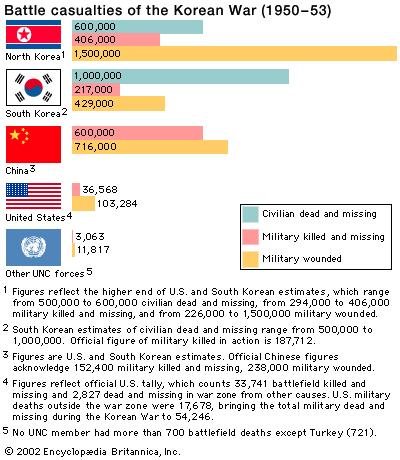

Revolution, division, and partisan warfare, 1945–50
The Korean War had its immediate origins in the collapse of the Japanese empire at the end of World War II in September 1945. Unlike China, Manchuria, and the former Western colonies seized by Japan in 1941–42, Korea, annexed to Japan since 1910, did not have a native government or a colonial regime waiting to return after hostilities ceased. Most claimants to power were harried exiles in China, Manchuria, Japan, the U.S.S.R., and the United States. They fell into two broad categories. The first was made up of committed Marxist revolutionaries who had fought the Japanese as part of the Chinese-dominated guerrilla armies in Manchuria and China. One of these exiles was a minor but successful guerrilla leader named Kim Il-sung, who had received some training in Russia and had been made a major in the Soviet army. The other Korean nationalist movement, no less revolutionary, drew its inspiration from the best of science, education, and industrialism in Europe, Japan, and America. These “ultranationalists” were split into rival factions, one of which centred on Syngman Rhee, educated in the United States and at one time the president of a dissident Korean Provisional Government in exile.
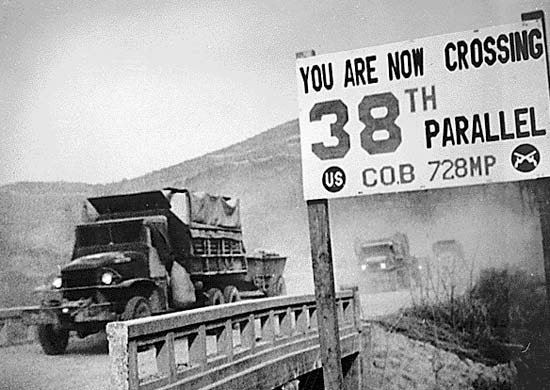
In their hurried effort to disarm the Japanese army and repatriate the Japanese population in Korea (estimated at 700,000), the United States and the Soviet Union agreed in August 1945 to divide the country for administrative purposes at the 38th parallel (latitude 38° N). At least from the American perspective, this geographic division was a temporary expedient; however, the Soviets began a short-lived reign of terror in northern Korea that quickly politicized the division by driving thousands of refugees south. The two sides could not agree on a formula that would produce a unified Korea, and in 1947 U.S. President Harry S. Truman persuaded the United Nations (UN) to assume responsibility for the country, though the U.S. military remained nominally in control of the South until 1948. Both the South Korean national police and the constabulary doubled in size, providing a southern security force of about 80,000 by 1947. In the meantime, Kim Il-sung strengthened his control over the Communist Party as well as the northern administrative structure and military forces. In 1948 the North Korean military and police numbered about 100,000, reinforced by a group of southern Korean guerrillas based at Haeju in western Korea.
The creation of an independent South Korea became UN policy in early 1948. Southern communists opposed this, and by autumn partisan warfare had engulfed parts of every Korean province below the 38th parallel. The fighting expanded into a limited border war between the South’s newly formed Republic of Korea Army (ROKA) and the North Korean border constabulary as well as the North’s Korean People’s Army (KPA). The North launched 10 cross-border guerrilla incursions in order to draw ROKA units away from their guerrilla-suppression campaign in the South.
In its larger purpose the partisan uprising failed: the Republic of Korea (ROK) was formed in August 1948, with Syngman Rhee as president. Nevertheless, almost 8,000 members of the South Korean security forces and at least 30,000 other Koreans lost their lives. Many of the victims were not security forces or armed guerrillas at all but simply people identified as “rightists” or “reds” by the belligerents. Small-scale atrocities became a way of life.
The partisan war also delayed the training of the South Korean army. In early 1950, American advisers judged that fewer than half of the ROKA’s infantry battalions were even marginally ready for war. U.S. military assistance consisted largely of surplus light weapons and supplies. Indeed, General Douglas MacArthur, commander of the United States’ Far East Command (FECOM), argued that his Eighth Army, consisting of four weak divisions in Japan, required more support than the Koreans.
Invasion and counterinvasion, 1950–51
South to Pusan
In early 1949 Kim Il-sung pressed his case with Soviet leader Joseph Stalin that the time had come for a conventional invasion of the South. Stalin refused, concerned about the relative unpreparedness of the North Korean armed forces and about possible U.S. involvement. In the course of the next year, the communist leadership built the KPA into a formidable offensive force modeled after a Soviet mechanized army. The Chinese released Korean veterans from the People’s Liberation Army, while the Soviets provided armaments. By 1950 the North Koreans enjoyed substantial advantages over the South in every category of equipment. After another Kim visit to Moscow in March–April 1950, Stalin approved an invasion.
In the predawn hours of June 25, the North Koreans struck across the 38th parallel behind a thunderous artillery barrage. The principal offensive, conducted by the KPA I Corps (53,000 men), drove across the Imjin River toward Seoul. The II Corps (54,000 soldiers) attacked along two widely separated axes, one through the cities of Ch’unch’ŏn and Inje to Hongch’ŏn and the other down the east coast road toward Kangnŭng. (See the map.) The KPA entered Seoul in the afternoon of June 28, but the North Koreans did not accomplish their goal of a quick surrender by the Rhee government and the disintegration of the South Korean army. Instead, remnants of the Seoul-area ROKA forces formed a defensive line south of the Han River, and on the east coast road ROKA units gave ground in good order. Still, if the South was to stave off collapse, it would need help—from the U.S. armed forces.
Truman’s initial response was to order MacArthur to transfer munitions to the ROKA and to use air cover to protect the evacuation of U.S. citizens. Instead of pressing for a congressional declaration of war, which he regarded as too alarmist and time-consuming when time was of the essence, Truman went to the United Nations for sanction. Under U.S. guidance, the UN called for the invasion to halt (June 25), then for the UN member states to provide military assistance to the ROK (June 27). By charter the Security Council considered and passed the resolutions, which could have been vetoed by a permanent member such as the Soviet Union. The Soviets, however, were boycotting the Council over the issue of admitting communist China to the UN. Congressional and public opinion in the United States, meanwhile, supported military intervention without significant dissent.
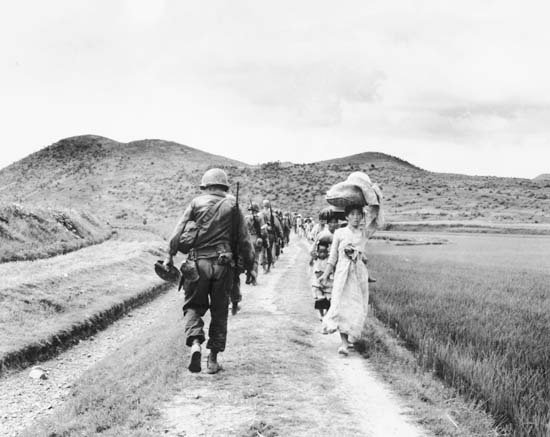
Having demonstrated its political will, the Truman administration faced the unhappy truth that it did not have much effective military power to meet the invasion. MacArthur secured the commitment of three divisions from Japan, but U.S. ground forces only expanded the scope of defeat. For almost eight weeks, near Osan, along the Kum River, through Taejŏn, and south to Taegu, U.S. soldiers fought and died—and some fled. Weakened by inadequate weapons, limited numbers, and uncertain leadership, U.S. troops were frequently beset by streams of refugees fleeing south, which increased the threat of guerrilla infiltration. These conditions produced unfortunate attacks on Korean civilians, such as the firing on hundreds of refugees at a railroad viaduct near the hamlet of Nogun-ri, west of the Naktong River, during the last week in July.
It was not until the first weeks of August that the United Nations Command, or UNC, as MacArthur’s theatre forces had been redesignated, started to slow the North Koreans. The Eighth Army, commanded by Lieutenant General Walton H. Walker, one of the best corps commanders in Europe in 1944–45, and the ROKA, led by Major General Chung Il-kwon, rallied and fought back with more success. Supplies came through the port at Pusan, where the Eighth Army’s logistics system depended on Korean and Japanese technicians and on thousands of Korean labourers. To stop the North Koreans’ tanks and supporting artillery and infantry, Walker brought in Sherman and Pershing medium tanks, rocket launchers, artillery pieces, antiaircraft guns, and, most important of all, close-air-support aircraft. The Fifth Air Force attacked forward units of the KPA with World War II-era P-51 Mustangs, new jet-powered F-80s and F-84s, and even B-26 and B-29 bombers. U.S. Marine Corps squadrons, embarked on navy light carriers, were capable of flying anywhere along the front in quick response to requests from ground forces, and on the east coast the U.S. Navy’s cruisers and destroyers became a seagoing heavy artillery for the ROK I Corps. Meanwhile, fresh U.S. Army and Marine Corps units began to arrive, supplemented by a British Commonwealth brigade. In the same period, the ROKA, which had shrunk to half its prewar strength through deaths, surrenders, a few defections, and substantial desertions, began to bring its ranks back up with reservists, student volunteers, and men impressed from cities’ streets as the South Koreans fell back.
Concerned that the shift of combat power toward the UNC would continue into September, the field commander of the KPA, General Kim Chaek, ordered an advance against the Naktong River–Taegu–Yŏngdŏk line, soon to become famous as the “Pusan Perimeter.” (See the map.) The major effort was a double envelopment of Taegu, supplemented by drives toward Masan and P’ohang, the southwestern and northeastern coastal anchors of the perimeter. None reached significant objectives. At the Battle of Tabu-dong (August 18–26), the ROK 1st Division and the U.S. 27th Regimental Combat Team defeated the North Koreans’ main armoured thrust toward Taegu. By September 12 the KPA, its two corps reduced to 60,000 men and its tank forces destroyed, had been driven back in most places west of the Naktong and well away from Taegu and P’ohang. At that moment the entire strategic balance of the war was shifted by the sudden appearance of the X Corps at Inch’ŏn.
North to the Yalu
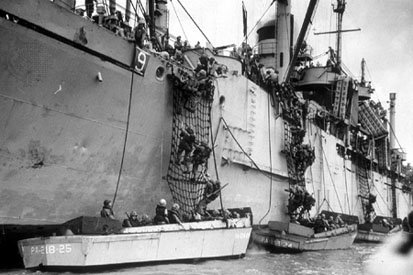
MacArthur did not believe that he could win the war without an amphibious landing deep behind enemy lines, and he had started to think about a landing as early as July. For the core of his landing force, he and the Joint Chiefs of Staff selected the 1st Marine Division and the Eighth Army’s remaining infantry division, the 7th. As the force developed, it also included South Korean marine and infantry units and an assortment of U.S. support troops. The entire force was designated X Corps and was commanded by Major General Edward M. Almond, MacArthur’s chief of staff.
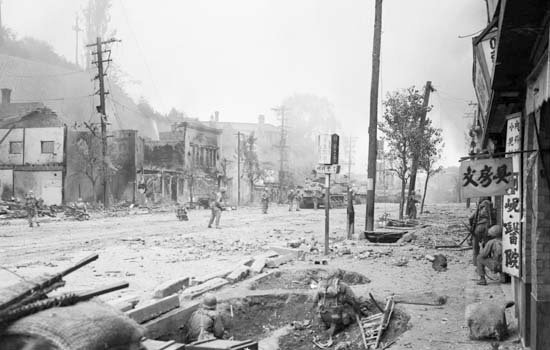
For the landing site, MacArthur himself fixed on Inch’ŏn, the port outlet of Seoul on Korea’s west coast. A host of problems defied a landing there: wide tidal variance, mines, a crazy quilt of islands and shoal waters, and dangerous proximity to KPA reinforcements from Seoul. MacArthur brushed off all these concerns. After a naval gun and aerial bombardment on September 14, marines the next day assaulted a key harbour defense site, Wŏlmi Island, and then in the late afternoon took Inch’ŏn itself. The North Korean resistance was stubborn but spread thin, and the 1st Marine Division, accompanied by ROK and U.S. army units, entered Seoul on September 25. The bulk of the 7th Division advanced to Suwŏn, where it contacted the Eighth Army on the 26th (see the map). MacArthur and Syngman Rhee marched into the damaged capitol building and declared South Korea liberated.
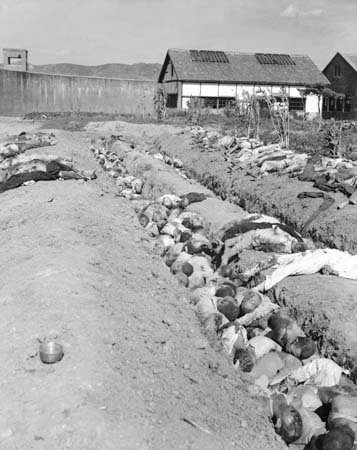
As an organized field force, the KPA disintegrated, having lost 13,000 as prisoners and 50,000 as casualties in August and September. Nevertheless, about 25,000 of its best troops took to the mountains and marched home as cohesive units; another 10,000 remained in South Korea as partisans. As the communists headed north, they took thousands of South Koreans with them as hostages and slave labourers and left additional thousands executed in their wake—most infamously at Taejŏn, where 5,000 civilians were massacred. The ROK army and national police, for their part, showed little sympathy to any southern communists they found or suspected, and U.S. aircraft attacked people and places with little restraint. As a result, the last two weeks of September saw atrocities rivaling those seen in Europe during the fratricidal Thirty Years’ War of the 17th century.
Even before the Inch’ŏn landing, MacArthur had thought ahead to a campaign into North Korea, though his plans never went beyond establishing a line across the so-called waist of Korea, from P’yŏngyang in the west to Wŏnsan in the east. On September 27 the Joint Chiefs gave him final authority to conduct operations north of the 38th parallel; however, he was instructed to limit operations in the event of Russian or Chinese intervention. For the UNC the war aim was expanded. As announced by the UN General Assembly on October 7, it was to include the occupation of all of North Korea and the elimination of the KPA as a threat to the political reconstruction of Korea as one nation. To that end, ROKA units crossed the parallel on October 1, and U.S. Army units crossed on October 7. The ROK I Corps marched rapidly up the east coast highway, winning the race for Wŏnsan; P’yŏngyang fell to the U.S. I Corps on October 19. The Kim Il-sung government, with the remnants of nine KPA divisions, fell back to the mountain town of Kanggye. Two other divisions, accompanied by Soviet advisers and air defense forces, struggled northwest toward the Yalu River and the Chinese border at Sinŭiju. The UNC assumed that the KPA had lost its will to fight. In reality, it was awaiting rescue.
Back to the 38th parallel
As UNC troops crossed the 38th parallel, Chinese Communist Party Chairman Mao Zedong received a plea for direct military aid from Kim Il-sung. The chairman was willing to intervene, but he needed assurances of Soviet air power. Stalin promised to extend China’s air defenses (manned by Soviets) to a corridor above the Yalu, thus protecting air bases in Manchuria and hydroelectric plants on the river, and he also promised new Soviet weapons and armaments factories. After much debate, Mao ordered the Renmin Zhiyuanjun, or Chinese People’s Volunteers Force (CPVF), to cross into Korea. It was commanded by General Peng Dehuai, a veteran of 20 years of war against the Chinese Nationalists and the Japanese.
The Chinese First Offensive (October 25–November 6, 1950) had the limited objective of testing U.S.-ROK fighting qualities and slowing their advance. In the battle of Onjŏng-Unsan along the Ch’ŏngch’ŏn River, the Chinese ruined seven Korean and U.S. regiments—including the only Korean regiment to reach the Yalu, cut off in the vastness of the cold northern hills near Ch’osan. The Chinese suffered 10,000 casualties, but they were convinced that they had found a formula for fighting UNC forces: attack at night, cut off routes of supply and withdrawal, ambush counterattacking forces, and exploit all forms of concealment and cover. Stunned by the suddenness of the Chinese onslaught and almost 8,000 casualties (6,000 of them Koreans), the Eighth Army fell back to the south bank of the Ch’ŏngch’ŏn and tightened its overextended lines. With a harsh winter beginning and supplies in shortage, the pause was wise.
Another matter of concern to the UNC was the appearance of MiG-15 jet fighters above North Korea. Flown by Soviet pilots masquerading as Chinese and Koreans, the MiGs, in one week’s action (November 1–7), stopped most of the daytime raids on North Korea. The U.S. Air Force immediately dispatched a crack wing of F-86 Sabre jet interceptors to Japan, and thus a two-and-a-half year battle for air superiority was joined. Over the course of the war, the F-86s succeeded in allowing the Far East Air Forces (FEAF) to conduct offensive air operations anywhere in North Korea, and they also protected the Eighth Army from communist air attack. However, they were never able to provide perfect protection for B-29s flying daylight raids into “MiG Alley,” a corridor in northwestern Korea where MiGs based near An-tung, Manchuria (now Dandong, China), fiercely defended bridges and dams on the Yalu River. (See the map.)
The FEAF also turned its fury on all standing structures that might shield the Chinese from the cold; cities and towns all over North Korea went up in flames. But the air assault did not halt the buildup for the Chinese Second Offensive. This time Peng’s instructions to his army commanders stressed the necessity to lure the Americans and “puppet troops” out of their defensive positions between the Ch’ŏngch’ŏn and P’yŏngyang, giving the impression of weakness and confusion, while Peng would surround their forward elements with his much-enlarged force of 420,000 Chinese and North Korean regulars. MacArthur, in what may have been his only real military mistake of the war, ordered the Eighth Army and X Corps northward into the trap on November 24, and from November 25 to December 14 the Chinese battered them back to South Korea. Falling upon the U.S. IX Corps and the ROK II Corps from the east, Peng’s Thirteenth Army Group opened up a gap to the west and almost cut off the I Corps north of the Ch’ŏngch’ŏn. The I Corps managed to fight its way through Chinese ambushes back to P’yŏngyang. In the eastern sector the Chinese Ninth Army Group sent two armies against the 1st Marine Division near the Changjin Reservoir (known to the Americans by its Japanese name, Chosin). Under the worst possible weather conditions, the marines turned and fought their way south, destroying seven Chinese divisions before reaching sanctuary at the port of Hŭngnam on December 11.
At the height of the crisis, MacArthur conferred with Walker and Almond, and they agreed that their forces would try to establish enclaves in North Korea, thus preserving the option of holding the P’yŏngyang-Wŏnsan line. In reality, Walker had finally reached the limits of his disgust with MacArthur’s meddling and posturing, and he started his men south. By December 6 the Eighth Army had destroyed everything it could not carry and had taken the road for Seoul. Walker’s initiative may have saved his army, but it also meant that much of the rest of the war would be fought as a UNC effort to recapture ground surrendered with little effort in December 1950. Walker himself died in a traffic accident just north of Seoul on December 23 and was succeeded by Lieutenant General Matthew B. Ridgway.
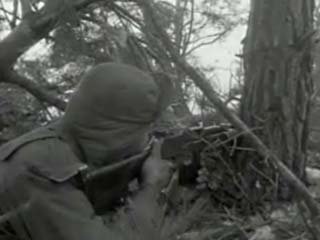
Heartened by the ease with which the CPVF had driven the UNC out of North Korea, Mao Zedong expanded his war aims to demand that the Chinese army unify all of Korea and drive the Americans and puppets off the peninsula. His enthusiasm increased when the Chinese Third Offensive (December 31, 1950–January 5, 1951) retook Seoul. The Chinese attacks centred on ROKA divisions, which were showing signs of defeatism and ineptness. Ridgway, therefore, had to rely in the short term upon his U.S. divisions, many of which had now gained units from other UN participants. In addition to two British Commonwealth brigades, there were units from Turkey, France, Belgium, The Netherlands, Greece, Colombia, Thailand, Ethiopia, and the Philippines. Pulling his multinational force together, Ridgway pushed back to the Han River valley in January 1951.
The Chinese, now reinforced by a reborn North Korean army, launched their Fourth Offensive on February 11, 1951. Again the initial attacks struck ill-prepared South Korean divisions, and again the UNC gave ground. Again the Eighth Army fought back methodically, crossing the 38th parallel after two months. At that point Peng began the Fifth Offensive (First Phase) with 11 Chinese armies and two North Korean corps. The attacks came at an awkward moment for the Eighth Army. On April 11 Truman, having reached the opinion that MacArthur’s independence amounted to insubordination, had relieved the general of all his commands and recalled him to the United States. The change elevated Ridgway to commander in chief, FECOM and UNC, and brought Lieutenant General James A. Van Fleet to command the Eighth Army. Like Ridgway, Van Fleet had earned wide respect as a division and corps commander against the Germans in 1944–45.
Before Van Fleet could re-form the ROK Army and redeploy his own divisions, the Chinese struck. At a low point in Korean military history, the battered ROKA II Corps gave way, and U.S. divisions peeled back to protect their flanks and rear until Van Fleet could commit five more U.S. and Korean divisions and a British brigade to halt the Chinese armies on April 28. Mao refused to accept Peng’s report that the CPVF could no longer hold the initiative, and he ordered the Second Phase of the offensive, which began on May 16 and lasted another bloody week. Once again allied air power and heavy artillery stiffened the resistance, and once again the UNC crossed the 38th parallel in pursuit of a battered (but not beaten) Chinese expeditionary force.
To the negotiating table
By June 1951 the Korean War had reached another critical point. The Chinese–North Korean armies, despite having suffered some 500,000 casualties since November, had grown to 1,200,000 soldiers. United Nations Command had taken its share of casualties—more than 100,000 since the Chinese intervention—but by May 1951 U.S. ground troops numbered 256,000, the ROKA 500,000, and other allied contingents 28,000. The U.S. FEAF had grown from fewer than 700 aircraft in July 1950 to more than 1,400 in February 1951.
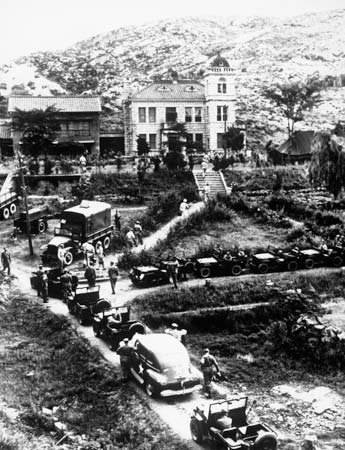
These developments obliged the leaders of both coalitions to consider that peace could not be imposed by either side through military victory—at least at acceptable cost. Truman and the UN, in particular, had lost their ardour for anything more than a return to status quo ante bellum and were sympathetic to the idea of a negotiated settlement. On May 17, 1951, the U.S. National Security Council adopted a new policy that committed the United States to support a unified, democratic Korea, but not necessarily one unified by military action and the overthrow of Kim Il-sung.
The communist road to a negotiated peace started in Beijing, where Mao, who had no desire to end the war, approved an approach suggested by Peng and others: hold the ground in Korea and conduct a campaign of attrition, attempting to win limited victories against small allied units through violent night attacks and infantry infiltration. Protection from UNC aircraft and artillery would be provided by caves and bunkers dug into the Korean mountains. Meanwhile, negotiations would be managed by the Chinese, an unparalleled chance to appear an equal of the United States in Asia and a slap at the hated Japanese. The Koreans were not a factor for either side.
After secret meetings between U.S. and Soviet diplomats, the Soviet Union announced that it would not block a negotiated settlement to the Korean War. The Truman administration had already alerted Ridgway to the prospect of truce talks, and on June 30 he issued a public statement that he had been authorized to participate in “a meeting to discuss an armistice providing for the cessation of hostilities.” On July 2 the Chinese and North Koreans issued a joint statement that they would discuss arrangements for a meeting, but only at their place of choice: the city of Kaesŏng, an ancient Korean capital, once part of the ROK but now occupied by the communists at the very edge of the front lines. The Chinese had just fired the first salvo of a new war, one in which talking and fighting for advantage might someday end the conflict.
Talking and fighting, 1951–53
Battling for position
From the time the liaison officers of both coalitions met on July 8, 1951, until the armistice agreement was signed on July 27, 1953, the Korean War continued as a “stalemate.” This characterization is appropriate in only two ways: (1) both sides had given up trying to unify Korea by force; and (2) the movement of armies on the ground never again matched the fluidity of the war’s first year. Otherwise, the word stalemate has no meaning, for the political-geographic stakes in Korea remained high.
As the negotiations at Kaesŏng developed, neither Ridgway nor Van Fleet believed that the talks would produce anything without more UNC offensives beyond the 38th parallel. Ridgway was particularly convinced that UNC forces should take the “Iron Triangle” (see the map), a key area between the headwaters of the Imjin River and the highest eastern mountain ranges that was anchored on the cities of Ch’ŏrwŏn (west), P’yŏnggang (north), and Kimhwa (east). Communist planners were equally convinced that control of this terrain offered advantages for defending North Korea or for continuing the war with offensives to the south and east.
Ground actions never actually ceased in 1951, but none matched the ferocity and frustration of the Eighth Army’s Autumn Offensive (August 31–November 12). Van Fleet’s general concept envisioned operations by the I Corps (five divisions) in the west and the X Corps (five divisions) in the central-eastern sector. In the I Corps sector, the ROK 1st Division and the British Commonwealth Division made notable advances beyond the Imjin valley, while other U.S. and ROK divisions advanced past Ch’ŏrwŏn and then stalled in heavy fighting. The X Corps, fighting a crack Chinese army and two North Korean corps, pushed northward through the mountains and succeeded only in making “Bloody Ridge,” “Heartbreak Ridge,” “The Punchbowl,” and Kanmubong Ridge bad memories for thousands of army and marine veterans. The KPA I, III, and VI Corps, holding the eastern mountains, proved especially difficult to dislodge, for Kim Il-sung had issued a “stand or die” order to his much-enlarged and improved armed forces. The most surprising advance occurred in the X Corps sector, where two U.S. and two ROK divisions pushed the Chinese back 15 km (almost 10 miles) from Kimhwa to Kŭmsong, pushing the front line out in a salient that exposed their flanks but also establishing a strong position to advance west to P’yŏnggang. The cost of the campaign troubled Van Fleet and Ridgway: 60,000 casualties, 22,000 of them American.
The campaign did not discourage the Chinese leadership, since in their eyes the strategy of “active defense” had worked. The UNC gave up major offensive operations in November, and the Chinese actually struck back in places with some success. Communist losses of some 100,000–150,000 were significant but not crippling—certainly not enough to drive the Chinese to end the war, only to talk some more about it.
In late October 1951 the communists agreed to move the truce negotiations to a more secure area, a village named P’anmunjŏm. Within two months they accepted the current line of contact between the armies as the military demarcation line; they also accepted related measures for the creation of a demilitarized zone (DMZ). The UNC accepted that there would be no verification activities outside of the DMZ, and both sides agreed to work on a regime for enforcement of the armistice after the shooting stopped. Much work on these items remained to be done, but the outline of an agreement was becoming apparent as the year ended—with one major exception: the handling of prisoners of war.
Battling over POWs
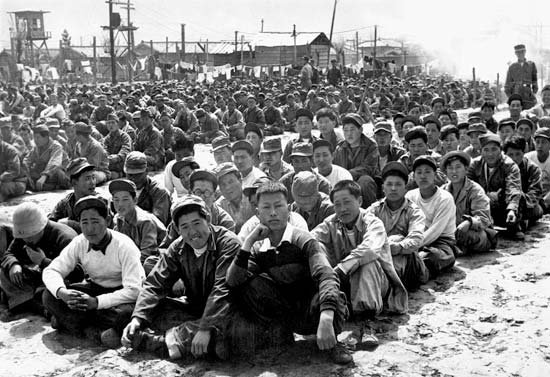
As another bitterly cold Korean winter congealed operations on the ground, repatriation of prisoners of war (POWs) became the most intractable issue at P’anmunjŏm. The initial assumption by the negotiators was that they would follow the revised Geneva Convention of 1949, which required any “detaining authority” that held POWs to return all of them to their homelands as rapidly as possible when a war ended. This “all for all” policy of a complete—even forced—exchange of prisoners was certainly favoured by the U.S. military, which was alarmed by early reports from Korea of atrocities against allied POWs. The South Korean government, on the other hand, was adamantly opposed to complete and involuntary repatriation, since it knew that thousands of detainees in the South were actually South Korean citizens who had been forced to fight with the KPA. Indeed, the North Koreans knew that they had much to answer for regarding their impressment, murder, and kidnapping of South Koreans. The Chinese army leaders, meanwhile, knew that some of their soldiers, impressed from the ranks of the Nationalist army, would refuse repatriation if it was not made mandatory.
Both sides agreed to exchange the names of POWs and the numbers held in various categories. The results of the tally shocked all the participants. The U.S. armed forces were carrying 11,500 men as missing in action (MIA), but the communists reported only 3,198 Americans in their custody (as well as 1,219 other UNC POWs, mostly Britons and Turks). The accounting for the South Koreans was even worse: of an estimated 88,000 MIAs, only 7,142 names were listed. The numbers fed the fears of the allies that the murder rate of POWs had been even worse than they suspected. In truth, most of the MIAs had died in battle, but perhaps 15,000 (all but 2,000 of them South Koreans) had died in communist hands from torture, execution, starvation, and medical mistreatment.
The communists, too, found little comfort in the numbers. Early unofficial estimates of POWs in UNC custody had been either too low, around 90,000, or too high, around 170,000. Now the official list produced 95,531 North Koreans, 20,700 Chinese, and 16,243 South Koreans, for a total of 132,474. The UNC reported that the 40,000 “missing” men were South Koreans who had already passed loyalty investigations and would not be counted as potential repatriates. Against this background, Truman ruled in January 1952 that no POW in UNC custody would be forced to return to North Korea or China against his will. Koreans choosing to go north would be exchanged on a “one for one” formula until all 12,000 allied POWs had been returned. Such a process, however, would require extensive screening of individuals about their preferences, a condition that soon created open warfare in the camps.
The communists had taken steps in 1951 to infiltrate political officers into the UNC POW camps, and now orders came from P’yŏngyang to obstruct the screening process without regard for loss of life. The goal was to make the POWs so obnoxious that the UNC would use force if necessary to send every one of them back to communist control. And so, beginning in December 1951, a series of revolts broke out “inside the wire,” culminating in pitched battles between armed prisoners and entire guard battalions in which hundreds of POWs and a small number of UNC troops lost their lives. Finally, in May 1952, General Mark W. Clark, who had just replaced Ridgway as UNC commander, ordered the execution of Operation BREAKUP, which over the following months crushed the revolt with tanks, gas, and bullets. By the end of the year, all the Chinese had been sent to Cheju Island, repatriate and nonrepatriate POWs segregated, refugees resettled, some of the communist intelligence network disrupted, and camp administration improved. Vigilantism and gang warfare never ceased entirely, however.
Guerrilla warfare
The POW revolt was only one aspect of the “other war” raging behind UNC lines. Another was waged by communist partisans and stay-behind units of the KPA, who, based in South Korea’s mountainous southern provinces, plagued the UNC lines of communication, rear-area camps, and Korean towns. In the autumn of 1951 Van Fleet ordered Major General Paik Sun-yup, one of the ROKA’s most effective officers, to break the back of guerrilla activity. From December 1951 to March 1952, ROK security forces killed 11,090 partisans and sympathizers and captured 9,916 more—a ratio suggesting something close to a “scorched earth, no-quarter” policy. Previous ROKA counterguerrilla operations had resulted in the war’s worst atrocity by a UNC unit, the execution of 800 to 1,000 villagers at Kŏch’ang in February 1951.
Air warfare
Air power gave the UNC its greatest hope to offset Chinese manpower and increasing firepower. The FEAF clearly won the battle for air superiority, pitting fewer than 100 F-86s against far more numerous Soviet, Chinese, and North Korean MiG-15s. Pilots from all the U.S. armed forces downed at least 500 MiGs at a loss of 78 F-86s. The Soviets rotated squadrons of their air defense force to Korea, losing more than 200 pilots.
Strategic bombing was at first limited by policy to attacks on North Korean cities and military installations—a campaign pursued until P’yŏngyang resembled Hiroshima or Tokyo in 1945. In 1952 the bombing of power plants and dams along the Yalu was authorized, and the following year approval was given to attack dams and supporting irrigation systems in North Korea. The bombing caused great suffering for the North Koreans, but they had to follow the Chinese and Russians in the war’s strategic direction, and the Chinese and Russians were hurt very little.
Throughout the war U.S. political and military leaders studied the possible use of nuclear weapons, and upon four separate occasions they gave this study serious attention. The answer was always the same: existing atomic bombs, carried by modified B-29s, would have little effect except for leveling cities. The one time that Truman suggested (in December 1950) that he was considering the nuclear option, the British led the allied charge to stop such talk.
Without question the UNC air campaign hurt the communists, and in retaliation the Chinese and North Koreans (with Soviet collusion) treated captured pilots with special brutality. Air crewmen made up the largest single group of U.S. POWs who truly disappeared, presumably dying under interrogation in Manchuria, elsewhere in China, and possibly in Russia. The communists also claimed that FEAF bombers were spreading epidemic diseases among the civilian population, and they tortured captured American pilots until they extracted incriminating statements of terror bombing and germ warfare.
Strengthening the ROK
U.S. air power might have held the communists at bay in the near term, but the long-term security of the ROK depended on (1) the enlargement and improvement of its own armed forces and (2) the stability of its government. The first requirement was accomplished by the United States’ Korean Military Advisory Group, which modernized the ROKA and also organized an effective training program. In the political arena, however, the UNC had to deal with the aging Syngman Rhee, who was convinced that he had an unfinished divine mission to save Korea. In 1952 Rhee forced the National Assembly to make the election of the president a matter of popular vote, immediately calling an election and winning a second term with five million of the six million votes cast. Rhee’s political coup had a ripple effect that spread to the armistice negotiations, as his dogmatic opposition to a cease-fire increased in scope and vigour. Essentially, Rhee could not believe that a likely new Republican administration in Washington, led by two other venerable Cold Warriors, Dwight D. Eisenhower and John Foster Dulles, would be satisfied to have U.S. soldiers “die for a tie.” Neither could the Russians, Chinese, and North Koreans.
The final push
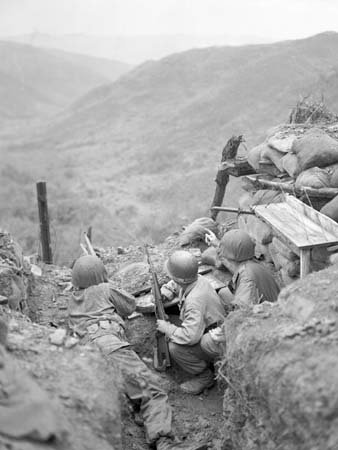
From September to November 1952, the Chinese expeditionary force staged its sixth major offensive of the war, this time to force the allies back to the 38th parallel and to inflict unacceptable casualties on them. Raging from the valley of the Imjin through the Iron Triangle to the eastern mountains, the ground war followed the same dismal pattern. The Chinese infiltrated allied outposts at night, then attacked under the support of short, intense artillery barrages. Submachine guns and hand grenades ruled the trenches, and flamethrowers and demolitions became standard weapons for assault units. Obscure hills acquired memorable names: White Horse Mountain, Bunker Hill, Old Baldy, Sniper Ridge, Capitol Hill, Triangle Hill, Pike’s Peak, Jackson Heights, and Jane Russell Hill. By the time fighting faded in mid-November, the Eighth Army had lost 10,000 men, the Chinese 15,000. Chinese commanders hoped that they had persuaded president-elect Eisenhower to abandon any ambitious plans for a major offensive in 1953.
The Chinese need not have worried, for both Eisenhower and secretary of state-designate Dulles viewed continuation of the Korean War as incompatible with U.S. national security interests. In their view the People’s Republic of China was indeed the enemy in Asia, but Korea was only one theatre in the struggle. They also knew that the voting public’s support for the war had thinned throughout 1952 as the talking and fighting continued abroad and the talking and taxing continued at home. As for the negotiations, Dulles conceded the communists’ point that voluntary repatriation should involve screening by an international agency, not just U.S.-ROK teams. When the UN and the International Committee of the Red Cross called for an exchange of sick and disabled POWs as a goodwill gesture, Eisenhower approved.
The plan proved a good test of communist intentions—by sheer chance. On March 5, 1953, Joseph Stalin died, and within weeks the Politburo of the Soviet Communist Party voted that the war in Korea should be ended. Mao Zedong received the news with dismay, but he knew that his army could not continue the war without Soviet assistance. With a speed that amazed the negotiating teams on both sides, the Chinese accepted voluntary repatriation. POWs who wanted to return to their homelands would be released immediately, and those who chose to stay would go into the custody of a neutral international agency for noncoercive screening. The Chinese and North Koreans also agreed to the exchange of sick and disabled POWs, which took place between April 20 and May 3.
Peace was not yet at hand, however. Rhee had never publicly surrendered his “march north and unify” position, and in private he hinted that he might “accept” an armistice only in return for serious commitments by the United States, including an unambiguous mutual security alliance and $1 billion in economic aid. The Chinese, meanwhile, saw but one way to win concessions and territory in a peace agreement: on the battlefield. Their seventh and final offensive opened in the Imjin River sector in May against U.S. and Commonwealth divisions, then shifted to the South Koreans, who were driven back 30 km (about 19 miles) from the Kŭmsong salient.
Armistice
The battle of the Kŭmsong salient ended the shooting war. On May 25 the P’anmunjŏm negotiators had worked out the details of the POW exchange, making provisions for “neutral nation” management of the repatriation process. They began to plan for an armistice signing. Then, on June 18–19, Syngman Rhee arranged for his military police to allow 27,000 Korean internees in their custody to “escape.” Enraged, the Chinese ordered further attacks on the ROKA. The Americans shared their fury but, in the interest of compromise, convinced Rhee that the United States would meet all his preconditions for an armistice. On July 9 Rhee agreed to accept the armistice, though no representative of the ROK ever signed it. On July 27 Mark W. Clark for the UNC, Peng Dehuai for the Chinese, and Kim Il-sung for the North Koreans signed the agreement. That same day the shooting stopped (more or less), and the armies began the awkward process of disengagement across what became a 4-km- (2.5-mile-) wide DMZ.
Supervision of the armistice actions fell to a Military Armistice Commission (10 officers representing the belligerents), a Neutral Nations Supervisory Commission (Sweden, Switzerland, Poland, and Czechoslovakia), and a Neutral Nations Repatriation Commission (the same four states, plus India as the custodian of the POWs). From August 5 to September 6, a total of 75,823 communist soldiers and civilians (all but 5,640 of them Koreans) returned to their most-favoured regime, and 7,862 ROK soldiers, 3,597 U.S. servicemen, and 1,377 persons of other nationalities (including some civilians) returned to UNC control. The swap became a media event of potent possibilities: the communist POWs stripped off their hated capitalist prison uniforms and marched off singing party-approved songs.
The handling of those who refused repatriation turned into a nightmare, as agents among the communist POWs and interrogators made life miserable for the Indians. By the time the Neutral Nations Repatriation Commission gave up the screening process in February 1954, only 628 Chinese and Koreans had changed their minds and gone north, and 21,839 had returned to UNC control. Most of the nonrepatriates were eventually settled in South Korea and Taiwan.
As provided for in the armistice agreement, the United States organized an international conference in Geneva for all the belligerents to discuss the political future of Korea. The actual meetings produced no agreement. The Korean peninsula would continue to be caught in the coils of Cold War rivalry, but the survival of the Republic of Korea kept alive the hope of civil liberties, democracy, economic development, and eventual unification—even if their fulfillment might require another 50 years or more.
Hi! I am a content-detection robot. This post is to help manual curators; I have NOT flagged you.
Here is similar content:
http://universalium.academic.ru/138624/Korean_War
NOTE: I cannot tell if you are the author, so ensure you have proper verification in your post (or in a reply to me), for humans to check!
Downvoting a post can decrease pending rewards and make it less visible. Common reasons:
Submit
sure @cheetah I 've been told in the first paragraph of this post this is not my article
Downvoting a post can decrease pending rewards and make it less visible. Common reasons:
Submit
Thank you! I didn't know a lot about the Korean war. I upvoted you. Please consider upvoting my post. https://steemit.com/steemit/@brianphobos/an-olympian-needs-our-help-steemit-please-read-this-if-you-have-ever-been-passionate-about-something
Downvoting a post can decrease pending rewards and make it less visible. Common reasons:
Submit
Thanks for the good article
Downvoting a post can decrease pending rewards and make it less visible. Common reasons:
Submit
Thanks for sharing the knowledge !
Downvoting a post can decrease pending rewards and make it less visible. Common reasons:
Submit
Downvoting a post can decrease pending rewards and make it less visible. Common reasons:
Submit